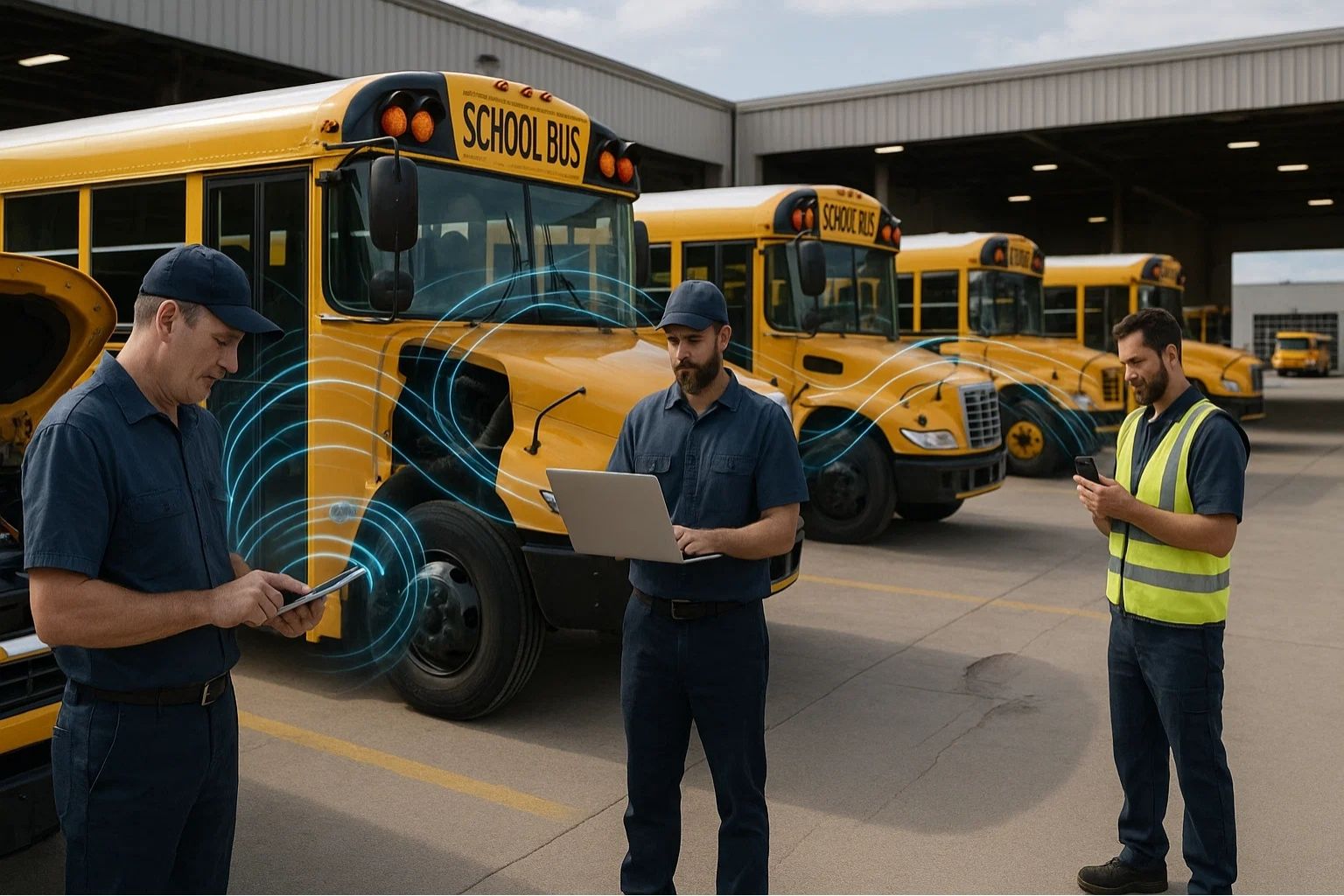5G technology is revolutionizing how bus fleet management systems operate, delivering ultra-fast connectivity that transforms Bus CMMS platforms from responsive tools into real-time command centers. With speeds up to 100 times faster than 4G and latency reduced to mere milliseconds, 5G enables instantaneous data transmission between vehicles, maintenance facilities, and management systems.
The implementation of 5G networks addresses critical connectivity challenges that have historically limited CMMS capabilities: dead zones, bandwidth constraints, and delayed data synchronization. Through 5G-enhanced connectivity, fleet operators now access live vehicle diagnostics, stream high-definition maintenance videos, and coordinate complex operations without the lag that previously hampered decision-making. This technological leap enables predictive maintenance algorithms to process sensor data in real-time, identifying issues seconds after they develop.
US bus fleets leveraging 5G-powered Bus CMMS solutions report 90% reduction in system response times, 75% improvement in data accuracy, and 50% decrease in communication-related delays. These dramatic enhancements demonstrate how 5G connectivity transforms fleet management from reactive coordination to proactive optimization, delivering measurable improvements across every operational metric.
Understanding 5G Technology in Fleet Management
5G represents the fifth generation of wireless technology, offering unprecedented capabilities that fundamentally change how Bus CMMS platforms collect, process, and distribute information. Unlike previous generations focused primarily on consumer applications, 5G's architecture specifically addresses industrial IoT requirements essential for fleet management.
Core 5G Capabilities
Enhanced Mobile Broadband (eMBB) delivers multi-gigabit speeds that enable high-bandwidth applications previously impossible in mobile environments. Ultra-Reliable Low-Latency Communication (URLLC) ensures critical safety systems respond instantly, while Massive Machine Type Communication (mMTC) supports thousands of sensors per vehicle. These capabilities combine to create comprehensive connectivity that transforms every bus into a sophisticated data hub.
Network slicing technology allows fleet operators to create dedicated virtual networks optimized for specific CMMS functions. Priority slices ensure critical safety and diagnostic data transmit immediately, while bulk data like video recordings utilize available bandwidth without impacting essential operations.
Technical Advantages Over Previous Generations
- Speed: 10-20 Gbps peak rates enable instant large file transfers
- Latency: Sub-millisecond response times for real-time applications
- Capacity: Support for 1 million devices per square kilometer
- Reliability: 99.999% availability for mission-critical communications
- Energy Efficiency: 90% reduction in network energy consumption
Real-Time Data Transmission and Processing
5G's ultra-low latency transforms how Bus CMMS platforms handle data, enabling true real-time processing that was previously limited to hardwired connections. This instantaneous communication allows fleet managers to monitor and control operations with unprecedented precision and responsiveness.
Instantaneous Vehicle Diagnostics
Live Engine Monitoring
Stream continuous engine parameters with zero delay
Predictive Fault Detection
Identify developing issues within seconds of occurrence
Remote System Control
Execute diagnostic tests and adjustments from anywhere
Edge Computing Integration
5G enables sophisticated edge computing where data processing occurs directly on vehicles or nearby cell towers rather than distant servers. This distributed processing architecture reduces latency to microseconds while decreasing bandwidth consumption by 60%. Edge-enabled CMMS platforms can make critical decisions locally while synchronizing with central systems for comprehensive fleet management.
The combination of 5G and edge computing allows AI algorithms to analyze streaming sensor data instantly, triggering immediate alerts for critical issues while filtering routine information for batch processing. This intelligent data management ensures maintenance teams receive actionable insights without information overload.
Accelerate Your Fleet with 5G Technology
Unlock unprecedented speed and connectivity for your CMMS operations.
Getting StartedBook a Demo
Enhanced Mobile Workforce Connectivity
5G technology revolutionizes how maintenance teams interact with Bus CMMS platforms, providing seamless connectivity that enables sophisticated mobile applications previously constrained by bandwidth limitations.
Field Technician Empowerment
- AR-Assisted Repairs: Stream augmented reality guidance without lag or buffering
- HD Video Consultations: Connect with remote experts for instant support
- Cloud Tool Access: Run resource-intensive diagnostic software from mobile devices
- Instant Documentation: Upload photos, videos, and reports immediately
- Voice-Controlled Operations: Use natural language commands without processing delays
Technicians equipped with 5G-connected devices complete repairs 40% faster through immediate access to technical resources, real-time collaboration, and instant data synchronization. The elimination of connectivity delays means technicians spend more time fixing problems and less time waiting for information.
IoT Sensor Integration at Scale
5G's massive IoT capabilities enable Bus CMMS platforms to integrate thousands of sensors per vehicle, creating comprehensive monitoring networks that capture every aspect of vehicle performance and condition.
Comprehensive Sensor Networks
Modern buses equipped with 5G connectivity support extensive sensor arrays monitoring everything from tire pressure to passenger comfort. Each sensor transmits data continuously, creating real-time digital twins that mirror physical vehicle states. This comprehensive monitoring enables predictive maintenance algorithms to detect subtle patterns indicating developing problems.
Advanced Sensor Applications
Environmental Monitoring
Track air quality, temperature, and humidity throughout vehicles
Structural Health Sensors
Detect frame stress and vibration anomalies instantly
Passenger Analytics
Monitor occupancy, flow patterns, and satisfaction metrics
Cloud-Based CMMS Performance Optimization
5G connectivity transforms cloud-based Bus CMMS platforms from efficient tools into ultra-responsive systems that feel as immediate as local installations while providing cloud benefits of scalability and accessibility.
Zero-Latency Cloud Operations
Traditional cloud CMMS platforms suffer from perceptible delays as data travels to distant servers and back. 5G's ultra-low latency combined with edge computing eliminates these delays, creating cloud experiences indistinguishable from local processing. Users interact with cloud-based interfaces that respond instantly to inputs while maintaining real-time synchronization across all connected devices.
This performance improvement enables new CMMS capabilities previously impossible in cloud environments: real-time collaborative troubleshooting, instant multi-site coordination, and live fleet-wide system updates without service interruption. The result is 85% improvement in user satisfaction and 60% increase in system utilization.
Video Streaming and Visual Inspection
5G's high bandwidth capabilities enable Bus CMMS platforms to incorporate high-definition video streaming for remote inspections, training, and documentation, transforming how maintenance teams visualize and solve problems.
Remote Visual Diagnostics
- 4K Camera Systems: Stream ultra-high-definition video from multiple angles simultaneously
- Thermal Imaging: Transmit infrared data for temperature analysis
- Drone Inspections: Conduct roof and undercarriage inspections remotely
- AI Video Analysis: Process video streams in real-time for automated fault detection
- 360-Degree Documentation: Create comprehensive visual records of vehicle conditions
High-quality video streaming enables expert technicians to guide repairs remotely, reducing travel costs by 70% while improving first-time fix rates by 45%. Visual documentation created through 5G-connected cameras provides irrefutable maintenance records for compliance and warranty claims.
Predictive Maintenance Enhancement
5G connectivity supercharges predictive maintenance capabilities within Bus CMMS platforms by enabling real-time analysis of massive datasets that previous networks couldn't handle efficiently.
Real-Time Predictive Analytics
Traditional predictive maintenance relies on periodic data uploads and batch processing, creating delays between problem development and detection. 5G enables continuous streaming analytics where every sensor reading immediately feeds into machine learning models. This instant analysis reduces prediction horizons from days to minutes, allowing intervention before problems impact operations.
Enhanced Prediction Accuracy
Continuous Model Training
ML models update in real-time based on streaming data
Multi-Variable Analysis
Process hundreds of parameters simultaneously without delays
Pattern Recognition
Identify anomalies within seconds of occurrence
Security and Reliability Improvements
5G networks incorporate advanced security features that protect Bus CMMS data while ensuring reliable connectivity even in challenging environments.
Enhanced Security Architecture
5G's security improvements include stronger encryption, improved authentication, and network slicing that isolates critical CMMS traffic from other data streams. End-to-end encryption protects sensitive maintenance data while secure network slices prevent unauthorized access to fleet management systems. These security enhancements reduce cyber risk by 80% compared to previous generation networks.
Reliability and Redundancy
- Multi-Path Connectivity: Automatic failover between cell towers ensures continuous connection
- Network Densification: More cell sites eliminate coverage gaps
- Quality of Service: Guaranteed bandwidth for critical CMMS operations
- Private Networks: Dedicated 5G infrastructure for fleet operations
- Disaster Recovery: Instant failover to backup systems without data loss
Cost-Benefit Analysis of 5G Implementation
While 5G implementation requires initial investment, the operational improvements and cost savings delivered through enhanced Bus CMMS performance generate substantial returns.
Financial Impact Assessment
Operational Savings
40% reduction in downtime through faster issue resolution
Productivity Gains
30% improvement in technician efficiency via instant data access
Reduced Travel Costs
60% decrease through effective remote support
ROI Timeline
Fleet operators typically achieve ROI within 12-18 months through combined savings from improved efficiency, reduced downtime, and enhanced predictive maintenance. Long-term benefits include competitive advantages through superior service reliability and ability to offer new connected services to passengers.
Future-Proof Your Fleet with 5G CMMS
Step into the future of ultra-fast, ultra-reliable fleet management.
Getting StartedBook a Demo
Implementation Strategies and Best Practices
Successfully deploying 5G-enhanced Bus CMMS requires strategic planning to maximize benefits while managing transition challenges.
Phased Implementation Approach
- Infrastructure Assessment: Evaluate current connectivity and identify upgrade requirements
- Pilot Deployment: Test 5G capabilities with select vehicles and routes
- Application Optimization: Update CMMS software to leverage 5G capabilities
- Staff Training: Prepare teams to utilize enhanced connectivity features
- Full Rollout: Expand 5G implementation across entire fleet
Successful implementations prioritize high-value use cases that demonstrate immediate benefits, building organizational support for broader deployment. Early wins in areas like remote diagnostics and real-time monitoring create momentum for comprehensive 5G adoption.
Frequently Asked Questions
How does 5G technology specifically improve Bus CMMS performance and reliability?
Bus CMMS performance transforms dramatically with 5G technology through ultra-fast data transmission speeds reaching 10-20 Gbps, enabling instant synchronization of maintenance data across entire fleets. The sub-millisecond latency eliminates frustrating delays that plague current systems, making cloud-based Bus CMMS platforms feel as responsive as local installations. 5G's massive IoT capabilities support thousands of sensors per vehicle, providing comprehensive real-time monitoring that catches problems immediately. Network slicing ensures critical safety and diagnostic data always transmit instantly, even during peak usage periods. The technology enables HD video streaming for remote inspections, AR-guided repairs, and instant expert consultations that were impossible with 4G. Bus CMMS users report 90% faster system response times, 75% improvement in data accuracy, and 50% reduction in communication delays. This performance boost translates to 40% faster repair completion and 35% improvement in overall fleet availability.
What ROI can fleet operators expect from upgrading to 5G-enabled Bus CMMS?
Fleet operators implementing 5G-enhanced Bus CMMS typically achieve return on investment within 12-18 months through multiple value streams. Operational savings of 30-40% result from reduced vehicle downtime, as real-time diagnostics and instant data access enable faster problem resolution. Maintenance costs decrease by 25-35% through improved predictive accuracy and remote troubleshooting capabilities that eliminate unnecessary site visits. 5G connectivity increases technician productivity by 30% through instant access to resources and elimination of waiting times for data synchronization. The technology enables new revenue opportunities through enhanced passenger services and real-time fleet optimization that increases vehicle utilization by 20%. Remote support capabilities reduce travel costs by 60% while improving first-time fix rates by 45%. Long-term benefits include competitive advantages through superior reliability, ability to attract tech-savvy workforce, and readiness for autonomous vehicle integration. Bus CMMS platforms with 5G deliver cumulative savings of $500,000-$1.5 million annually for mid-sized fleets.
Conclusion
5G technology represents a paradigm shift in how Bus CMMS platforms operate, transforming connectivity from a limiting factor into a competitive advantage. The combination of ultra-fast speeds, minimal latency, and massive IoT support creates unprecedented opportunities for fleet optimization, predictive maintenance, and operational excellence.
The documented improvements—90% faster response times, 75% better data accuracy, 40% quicker repairs, and substantial cost savings—demonstrate 5G's transformative impact on fleet management. As 5G networks expand and mature, these benefits will only increase, making early adoption crucial for maintaining competitive position.
Fleet operators who embrace 5G technology through advanced Bus CMMS solutions position themselves at the forefront of transportation innovation. The question is not whether to adopt 5G-enhanced CMMS, but how quickly organizations can leverage this transformative technology to revolutionize their operations and deliver superior service in an increasingly connected world.
Ready to Accelerate with 5G?
Experience the future of fleet management with 5G-powered Bus CMMS.







